trailer FIAT FIORINO 2007 Owner handbook (in English)
[x] Cancel search | Manufacturer: FIAT, Model Year: 2007, Model line: FIORINO, Model: FIAT FIORINO 2007Pages: 210, PDF Size: 3.22 MB
Page 79 of 210
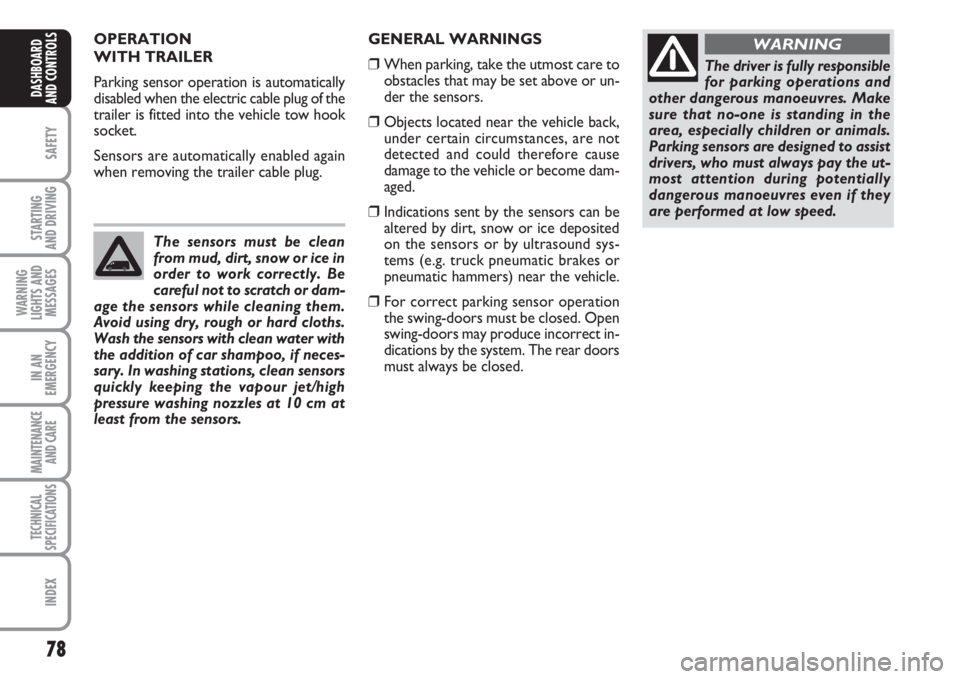
78
SAFETY
STARTING
AND DRIVING
WARNING
LIGHTS AND
MESSAGES
IN AN
EMERGENCY
MAINTENANCE
AND CARE
TECHNICAL
SPECIFICATIONS
INDEX
DASHBOARD
AND CONTROLS
OPERATION
WITH TRAILER
Parking sensor operation is automatically
disabled when the electric cable plug of the
trailer is fitted into the vehicle tow hook
socket.
Sensors are automatically enabled again
when removing the trailer cable plug.GENERAL WARNINGS
❒When parking, take the utmost care to
obstacles that may be set above or un-
der the sensors.
❒Objects located near the vehicle back,
under certain circumstances, are not
detected and could therefore cause
damage to the vehicle or become dam-
aged.
❒Indications sent by the sensors can be
altered by dirt, snow or ice deposited
on the sensors or by ultrasound sys-
tems (e.g. truck pneumatic brakes or
pneumatic hammers) near the vehicle.
❒For correct parking sensor operation
the swing-doors must be closed. Open
swing-doors may produce incorrect in-
dications by the system. The rear doors
must always be closed. The sensors must be clean
from mud, dirt, snow or ice in
order to work correctly. Be
careful not to scratch or dam-
age the sensors while cleaning them.
Avoid using dry, rough or hard cloths.
Wash the sensors with clean water with
the addition of car shampoo, if neces-
sary. In washing stations, clean sensors
quickly keeping the vapour jet/high
pressure washing nozzles at 10 cm at
least from the sensors.
The driver is fully responsible
for parking operations and
other dangerous manoeuvres. Make
sure that no-one is standing in the
area, especially children or animals.
Parking sensors are designed to assist
drivers, who must always pay the ut-
most attention during potentially
dangerous manoeuvres even if they
are performed at low speed.
WARNING
Page 102 of 210
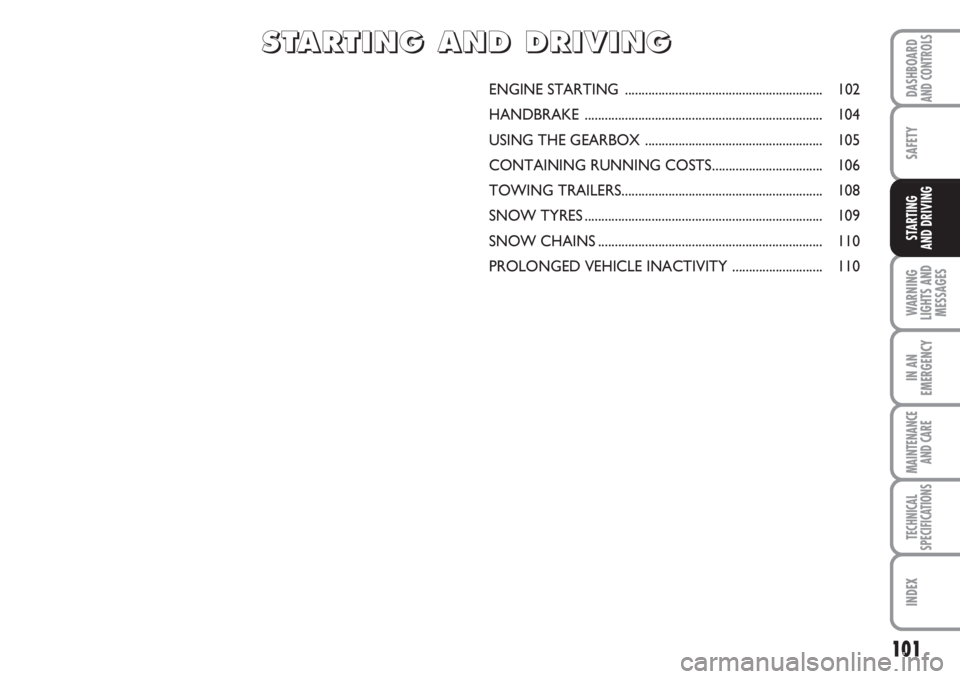
101
SAFETY
WARNING
LIGHTS AND
MESSAGES
IN AN
EMERGENCY
MAINTENANCE
AND CARE
TECHNICAL
SPECIFICATIONS
INDEX
DASHBOARDAND CONTROLS
STARTING
AND DRIVING
ENGINE STARTING ........................................................... 102
HANDBRAKE ....................................................................... 104
USING THE GEARBOX ..................................................... 105
CONTAINING RUNNING COSTS................................. 106
TOWING TRAILERS............................................................ 108
SNOW TYRES....................................................................... 109
SNOW CHAINS................................................................... 110
PROLONGED VEHICLE INACTIVITY ........................... 110
S S
T T
A A
R R
T T
I I
N N
G G
A A
N N
D D
D D
R R
I I
V V
I I
N N
G G
Page 107 of 210
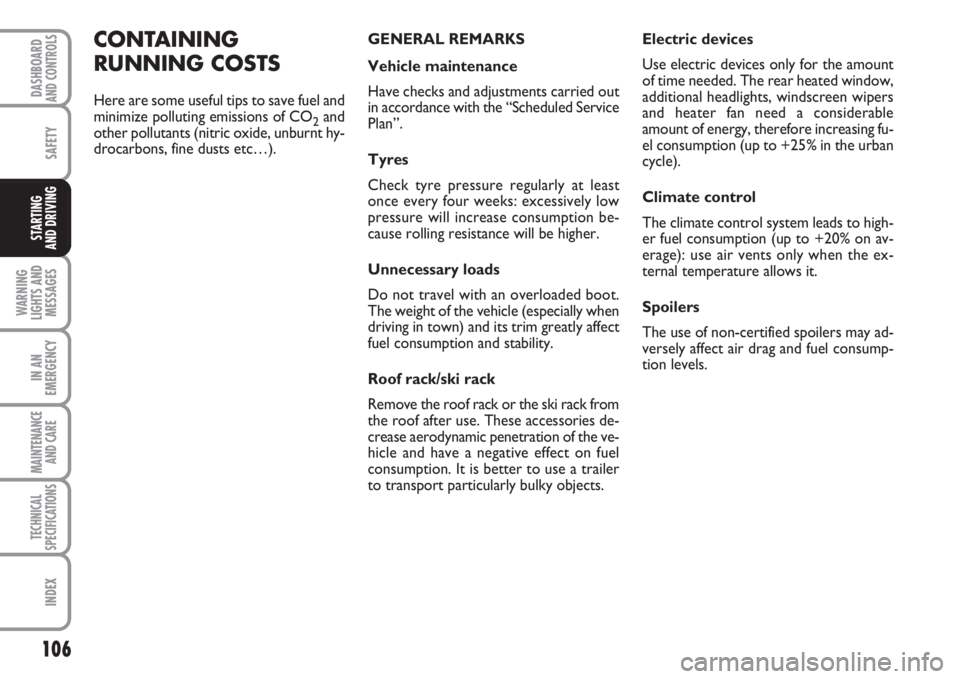
106
SAFETY
WARNING
LIGHTS AND
MESSAGES
IN AN
EMERGENCY
MAINTENANCE
AND CARE
TECHNICAL
SPECIFICATIONS
INDEX
DASHBOARDAND CONTROLS
STARTING
AND DRIVING
CONTAINING
RUNNING COSTS
Here are some useful tips to save fuel and
minimize polluting emissions of CO
2and
other pollutants (nitric oxide, unburnt hy-
drocarbons, fine dusts etc…).GENERAL REMARKS
Vehicle maintenance
Have checks and adjustments carried out
in accordance with the “Scheduled Service
Plan”.
Tyres
Check tyre pressure regularly at least
once every four weeks: excessively low
pressure will increase consumption be-
cause rolling resistance will be higher.
Unnecessary loads
Do not travel with an overloaded boot.
The weight of the vehicle (especially when
driving in town) and its trim greatly affect
fuel consumption and stability.
Roof rack/ski rack
Remove the roof rack or the ski rack from
the roof after use. These accessories de-
crease aerodynamic penetration of the ve-
hicle and have a negative effect on fuel
consumption. It is better to use a trailer
to transport particularly bulky objects.Electric devices
Use electric devices only for the amount
of time needed. The rear heated window,
additional headlights, windscreen wipers
and heater fan need a considerable
amount of energy, therefore increasing fu-
el consumption (up to +25% in the urban
cycle).
Climate control
The climate control system leads to high-
er fuel consumption (up to +20% on av-
erage): use air vents only when the ex-
ternal temperature allows it.
Spoilers
The use of non-certified spoilers may ad-
versely affect air drag and fuel consump-
tion levels.
Page 109 of 210
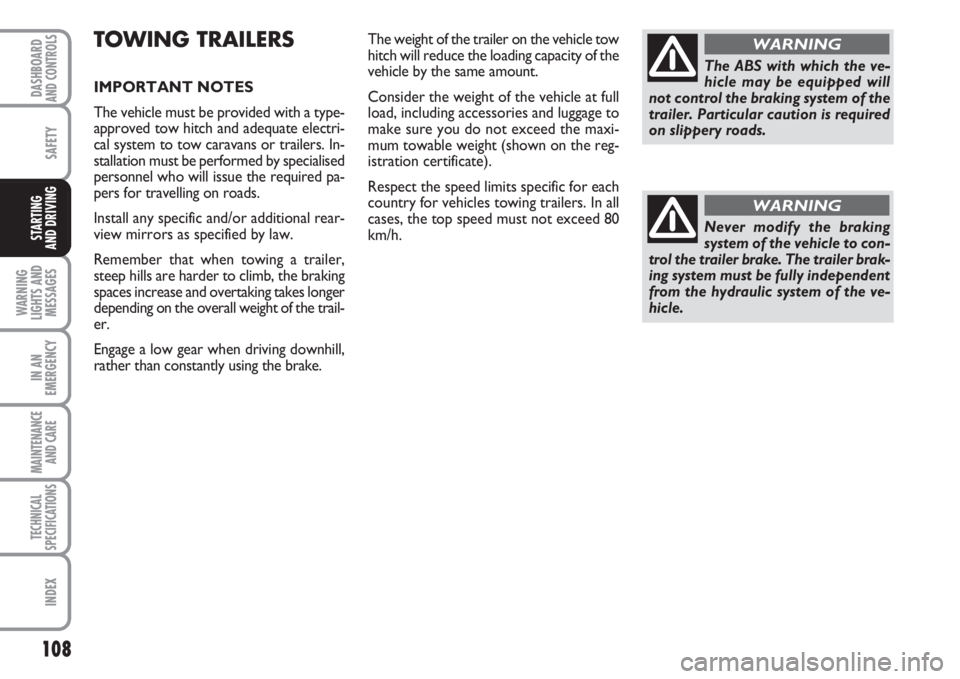
108
SAFETY
WARNING
LIGHTS AND
MESSAGES
IN AN
EMERGENCY
MAINTENANCE
AND CARE
TECHNICAL
SPECIFICATIONS
INDEX
DASHBOARDAND CONTROLS
STARTING
AND DRIVING
TOWING TRAILERS
IMPORTANT NOTES
The vehicle must be provided with a type-
approved tow hitch and adequate electri-
cal system to tow caravans or trailers. In-
stallation must be performed by specialised
personnel who will issue the required pa-
pers for travelling on roads.
Install any specific and/or additional rear-
view mirrors as specified by law.
Remember that when towing a trailer,
steep hills are harder to climb, the braking
spaces increase and overtaking takes longer
depending on the overall weight of the trail-
er.
Engage a low gear when driving downhill,
rather than constantly using the brake.
The ABS with which the ve-
hicle may be equipped will
not control the braking system of the
trailer. Particular caution is required
on slippery roads.
WARNING
Never modify the braking
system of the vehicle to con-
trol the trailer brake. The trailer brak-
ing system must be fully independent
from the hydraulic system of the ve-
hicle.
WARNING
The weight of the trailer on the vehicle tow
hitch will reduce the loading capacity of the
vehicle by the same amount.
Consider the weight of the vehicle at full
load, including accessories and luggage to
make sure you do not exceed the maxi-
mum towable weight (shown on the reg-
istration certificate).
Respect the speed limits specific for each
country for vehicles towing trailers. In all
cases, the top speed must not exceed 80
km/h.
Page 115 of 210
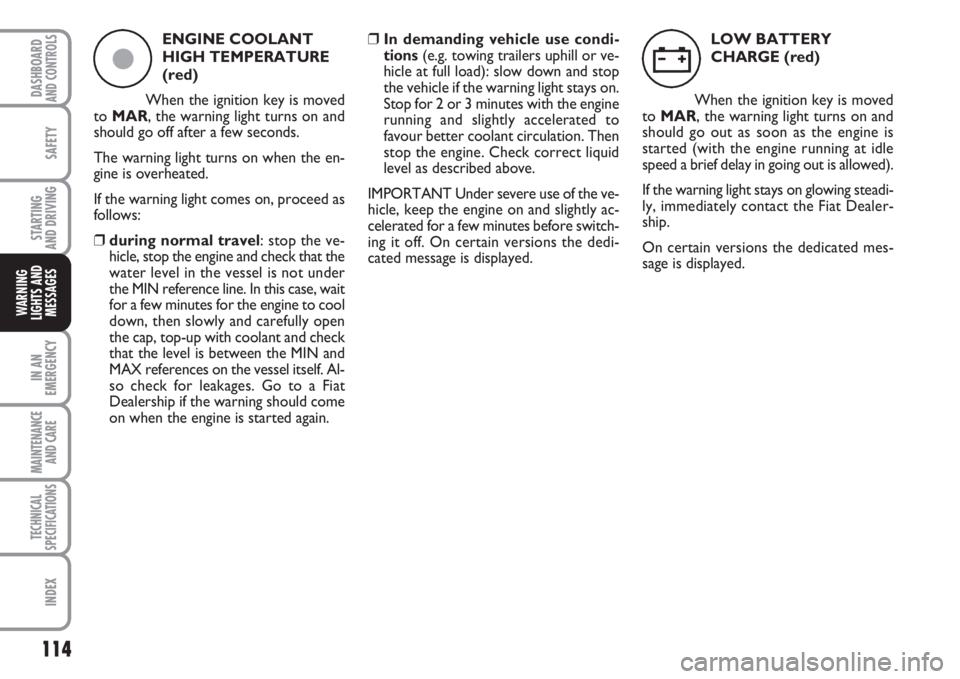
114
SAFETY
IN AN
EMERGENCY
MAINTENANCE
AND CARE
TECHNICAL
SPECIFICATIONS
INDEX
DASHBOARDAND CONTROLS
STARTING
AND DRIVING
WARNING
LIGHTS AND
MESSAGES
ENGINE COOLANT
HIGH TEMPERATURE
(red)
When the ignition key is moved
to MAR, the warning light turns on and
should go off after a few seconds.
The warning light turns on when the en-
gine is overheated.
If the warning light comes on, proceed as
follows:
❒during normal travel: stop the ve-
hicle, stop the engine and check that the
water level in the vessel is not under
the MIN reference line. In this case, wait
for a few minutes for the engine to cool
down, then slowly and carefully open
the cap, top-up with coolant and check
that the level is between the MIN and
MAX references on the vessel itself. Al-
so check for leakages. Go to a Fiat
Dealership if the warning should come
on when the engine is started again.❒In demanding vehicle use condi-
tions (e.g. towing trailers uphill or ve-
hicle at full load): slow down and stop
the vehicle if the warning light stays on.
Stop for 2 or 3 minutes with the engine
running and slightly accelerated to
favour better coolant circulation. Then
stop the engine. Check correct liquid
level as described above.
IMPORTANT Under severe use of the ve-
hicle, keep the engine on and slightly ac-
celerated for a few minutes before switch-
ing it off. On certain versions the dedi-
cated message is displayed.LOW BATTERY
CHARGE (red)
When the ignition key is moved
to MAR, the warning light turns on and
should go out as soon as the engine is
started (with the engine running at idle
speed a brief delay in going out is allowed).
If the warning light stays on glowing steadi-
ly, immediately contact the Fiat Dealer-
ship.
On certain versions the dedicated mes-
sage is displayed.
çw
Page 149 of 210
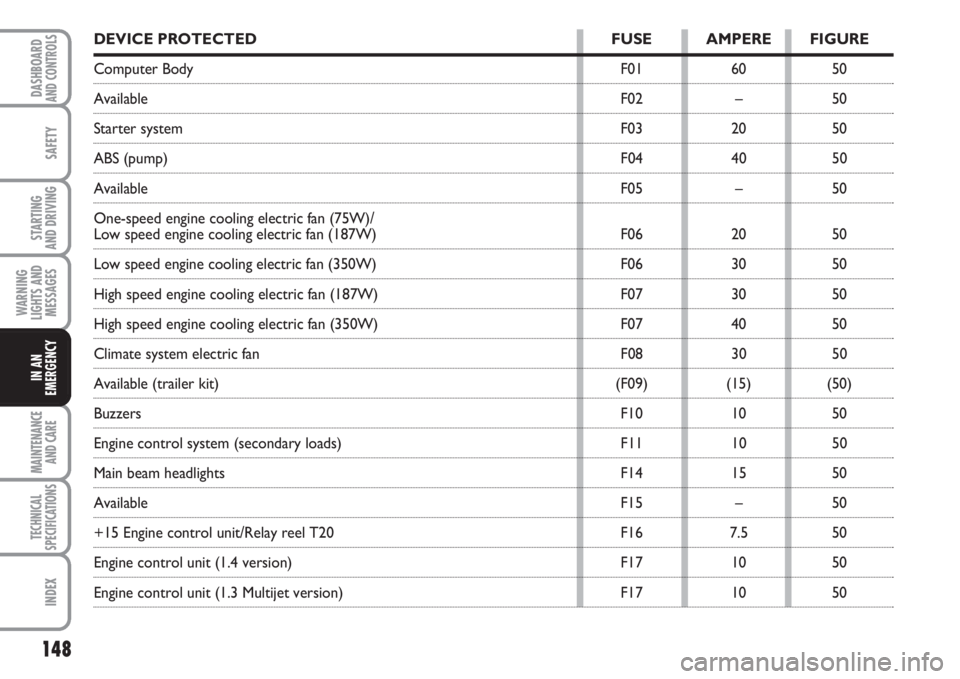
148
SAFETY
MAINTENANCE
AND CARE
TECHNICAL
SPECIFICATIONS
INDEX
DASHBOARDAND CONTROLS
STARTING
AND DRIVING
WARNING
LIGHTS AND
MESSAGES
IN AN
EMERGENCY
DEVICE PROTECTED FUSE AMPERE FIGURE
Computer Body F01 60 50
Available F02 – 50
Starter system F03 20 50
ABS (pump) F04 40 50
Available F05 – 50
One-speed engine cooling electric fan (75W)/
Low speed engine cooling electric fan (187W) F06 20 50
Low speed engine cooling electric fan (350W) F06 30 50
High speed engine cooling electric fan (187W) F07 30 50
High speed engine cooling electric fan (350W) F07 40 50
Climate system electric fan F08 30 50
Available (trailer kit) (F09) (15) (50)
Buzzers F10 10 50
Engine control system (secondary loads) F11 10 50
Main beam headlights F14 15 50
Available F15 – 50
+15 Engine control unit/Relay reel T20 F16 7.5 50
Engine control unit (1.4 version) F17 10 50
Engine control unit (1.3 Multijet version) F17 10 50
Page 162 of 210
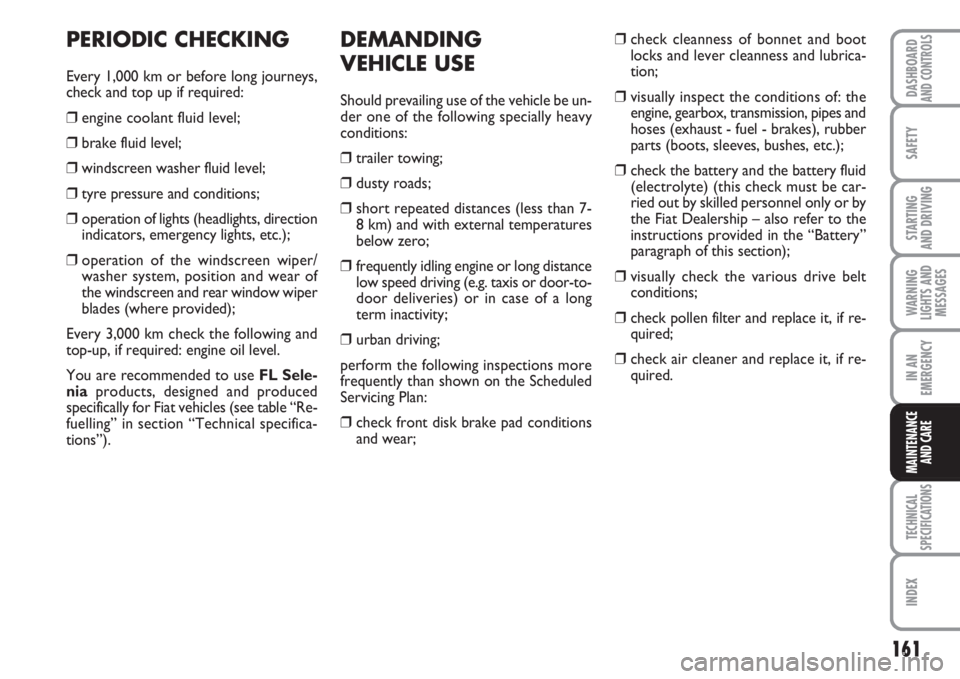
161
SAFETY
TECHNICAL
SPECIFICATIONS
INDEX
DASHBOARDAND CONTROLS
STARTING
AND DRIVING
WARNING
LIGHTS AND
MESSAGES
IN AN
EMERGENCY
MAINTENANCE
AND CARE
PERIODIC CHECKING
Every 1,000 km or before long journeys,
check and top up if required:
❒engine coolant fluid level;
❒brake fluid level;
❒windscreen washer fluid level;
❒tyre pressure and conditions;
❒operation of lights (headlights, direction
indicators, emergency lights, etc.);
❒operation of the windscreen wiper/
washer system, position and wear of
the windscreen and rear window wiper
blades (where provided);
Every 3,000 km check the following and
top-up, if required: engine oil level.
You are recommended to use FL Sele-
niaproducts, designed and produced
specifically for Fiat vehicles (see table “Re-
fuelling” in section “Technical specifica-
tions”).
DEMANDING
VEHICLE USE
Should prevailing use of the vehicle be un-
der one of the following specially heavy
conditions:
❒trailer towing;
❒dusty roads;
❒short repeated distances (less than 7-
8 km) and with external temperatures
below zero;
❒frequently idling engine or long distance
low speed driving (e.g. taxis or door-to-
door deliveries) or in case of a long
term inactivity;
❒urban driving;
perform the following inspections more
frequently than shown on the Scheduled
Servicing Plan:
❒check front disk brake pad conditions
and wear;❒check cleanness of bonnet and boot
locks and lever cleanness and lubrica-
tion;
❒visually inspect the conditions of: the
engine, gearbox, transmission, pipes and
hoses (exhaust - fuel - brakes), rubber
parts (boots, sleeves, bushes, etc.);
❒check the battery and the battery fluid
(electrolyte) (this check must be car-
ried out by skilled personnel only or by
the Fiat Dealership – also refer to the
instructions provided in the “Battery”
paragraph of this section);
❒visually check the various drive belt
conditions;
❒check pollen filter and replace it, if re-
quired;
❒check air cleaner and replace it, if re-
quired.
Page 179 of 210
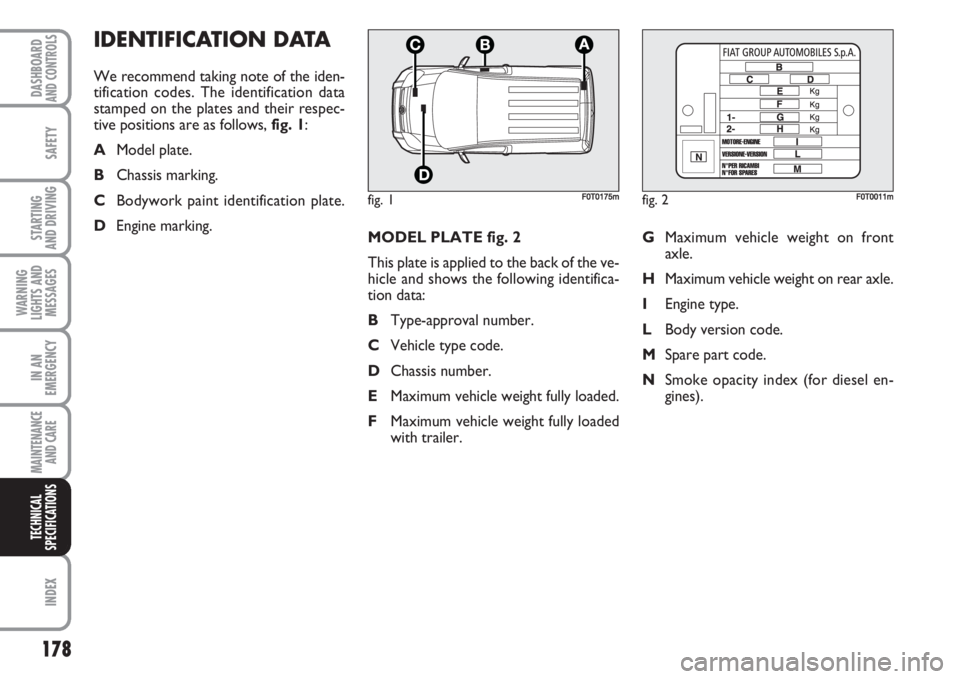
178
SAFETY
INDEX
DASHBOARDAND CONTROLS
STARTING
AND DRIVING
WARNING
LIGHTS AND
MESSAGES
IN AN
EMERGENCY
MAINTENANCE
AND CARE
TECHNICAL
SPECIFICATIONS
MODEL PLATE fig. 2
This plate is applied to the back of the ve-
hicle and shows the following identifica-
tion data:
BType-approval number.
CVehicle type code.
DChassis number.
EMaximum vehicle weight fully loaded.
FMaximum vehicle weight fully loaded
with trailer.GMaximum vehicle weight on front
axle.
HMaximum vehicle weight on rear axle.
IEngine type.
LBody version code.
MSpare part code.
NSmoke opacity index (for diesel en-
gines).
IDENTIFICATION DATA
We recommend taking note of the iden-
tification codes. The identification data
stamped on the plates and their respec-
tive positions are as follows, fig. 1:
AModel plate.
BChassis marking.
CBodywork paint identification plate.
DEngine marking.
fig. 1F0T0175mfig. 2F0T0011m
Page 191 of 210
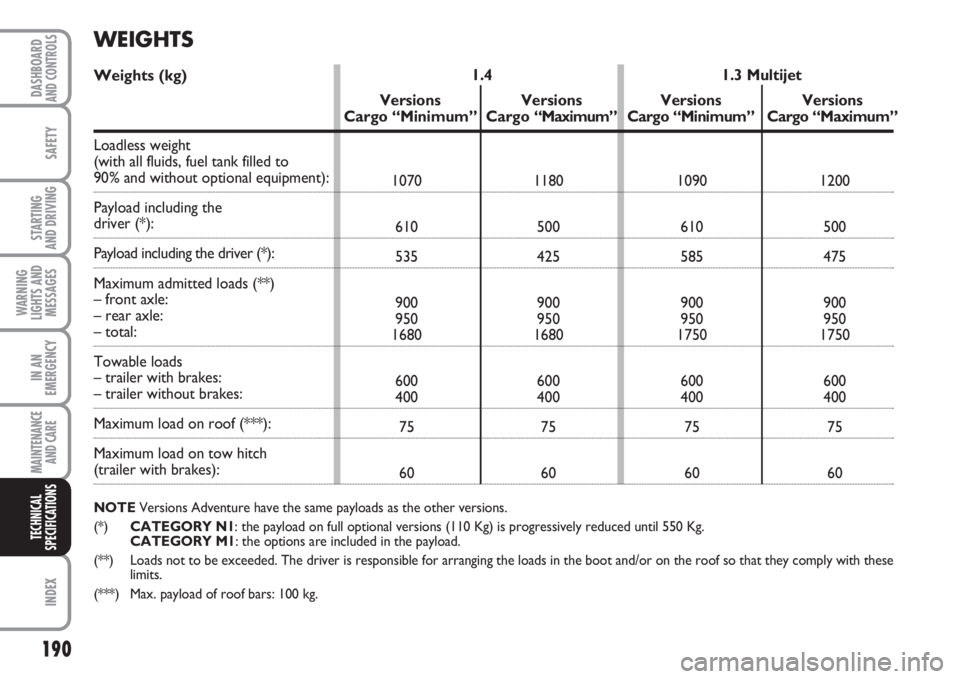
190
SAFETY
INDEX
DASHBOARDAND CONTROLS
STARTING
AND DRIVING
WARNING
LIGHTS AND
MESSAGES
IN AN
EMERGENCY
MAINTENANCE
AND CARE
TECHNICAL
SPECIFICATIONS
WEIGHTS
Weights (kg)
Loadless weight
(with all fluids, fuel tank filled to
90% and without optional equipment):
Payload including the
driver (*):
Payload including the driver (*):
Maximum admitted loads (**)
– front axle:
– rear axle:
– total:
Towable loads
– trailer with brakes:
– trailer without brakes:
Maximum load on roof (***):
Maximum load on tow hitch
(trailer with brakes):
NOTEVersions Adventure have the same payloads as the other versions.
(*)CATEGORY N1: the payload on full optional versions (110 Kg) is progressively reduced until 550 Kg.
CATEGORY M1: the options are included in the payload.
(**) Loads not to be exceeded. The driver is responsible for arranging the loads in the boot and/or on the roof so that they comply with these
limits.
(***) Max. payload of roof bars: 100 kg.
1.4
Versions Versions
Cargo “Minimum” Cargo “Maximum”
1070 1180
610 500
535 425
900 900
950 950
1680 1680
600 600
400 400
75 75
60 601.3 Multijet
Versions Versions
Cargo “Minimum” Cargo “Maximum”
1090 1200
610 500
585 475
900 900
950 950
1750 1750
600 600
400 400
75 75
60 60
Page 201 of 210
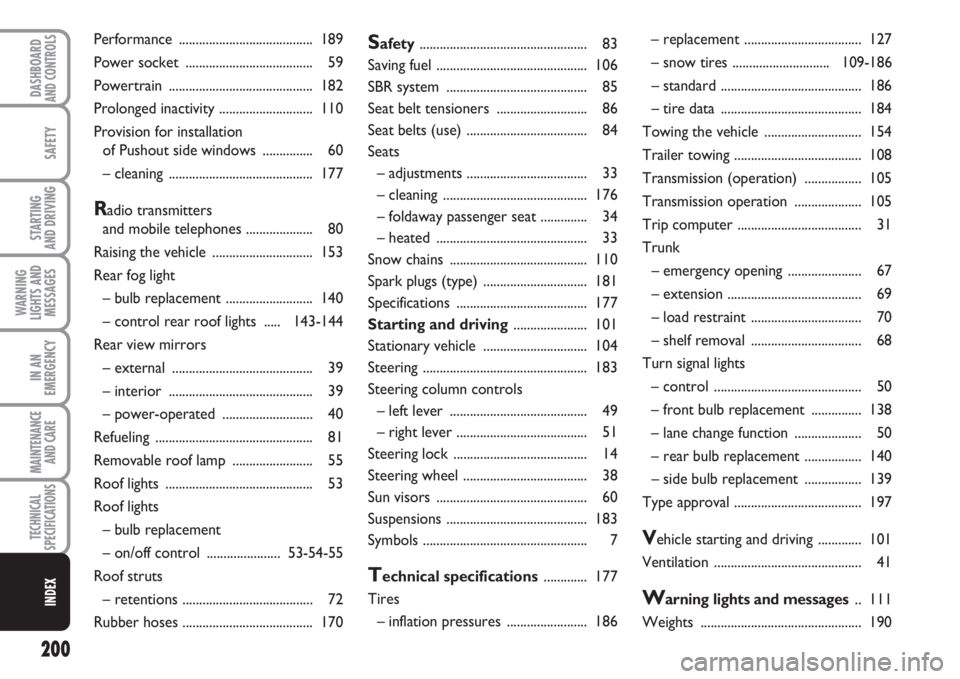
200
WARNING
LIGHTS AND
MESSAGES
DASHBOARDAND CONTROLS
SAFETY
STARTING
AND DRIVING
IN AN
EMERGENCY
MAINTENANCE
AND CARE
TECHNICAL
SPECIFICATIONS
INDEX
Safety.................................................. 83
Saving fuel ............................................. 106
SBR system .......................................... 85
Seat belt tensioners ........................... 86
Seat belts (use) .................................... 84
Seats
– adjustments .................................... 33
– cleaning ........................................... 176
– foldaway passenger seat .............. 34
– heated ............................................. 33
Snow chains ......................................... 110
Spark plugs (type) ............................... 181
Specifications ....................................... 177
Starting and driving...................... 101
Stationary vehicle ............................... 104
Steering ................................................. 183
Steering column controls
– left lever ......................................... 49
– right lever ....................................... 51
Steering lock ........................................ 14
Steering wheel ..................................... 38
Sun visors ............................................. 60
Suspensions .......................................... 183
Symbols ................................................. 7
Technical specifications............. 177
Tires
– inflation pressures ........................ 186– replacement ................................... 127
– snow tires .............................109-186
– standard .......................................... 186
– tire data .......................................... 184
Towing the vehicle ............................. 154
Trailer towing ...................................... 108
Transmission (operation) ................. 105
Transmission operation .................... 105
Trip computer ..................................... 31
Trunk
– emergency opening ...................... 67
– extension ........................................ 69
– load restraint ................................. 70
– shelf removal ................................. 68
Turn signal lights
– control ............................................ 50
– front bulb replacement ............... 138
– lane change function .................... 50
– rear bulb replacement ................. 140
– side bulb replacement ................. 139
Type approval ...................................... 197
Vehicle starting and driving ............. 101
Ventilation ............................................ 41
Warning lights and messages.. 111
Weights ................................................ 190 Performance ........................................ 189
Power socket ...................................... 59
Powertrain ........................................... 182
Prolonged inactivity ............................ 110
Provision for installation
of Pushout side windows ............... 60
– cleaning ........................................... 177
Radio transmitters
and mobile telephones .................... 80
Raising the vehicle .............................. 153
Rear fog light
– bulb replacement .......................... 140
– control rear roof lights ..... 143-144
Rear view mirrors
– external .......................................... 39
– interior ........................................... 39
– power-operated ........................... 40
Refueling ............................................... 81
Removable roof lamp ........................ 55
Roof lights ............................................ 53
Roof lights
– bulb replacement
– on/off control ......................53-54-55
Roof struts
– retentions ....................................... 72
Rubber hoses ....................................... 170